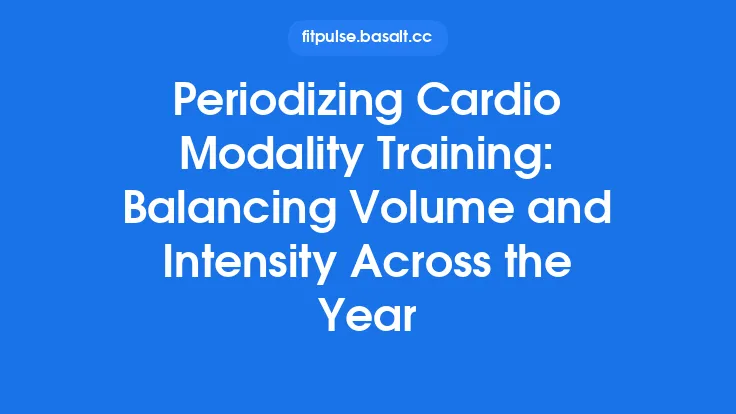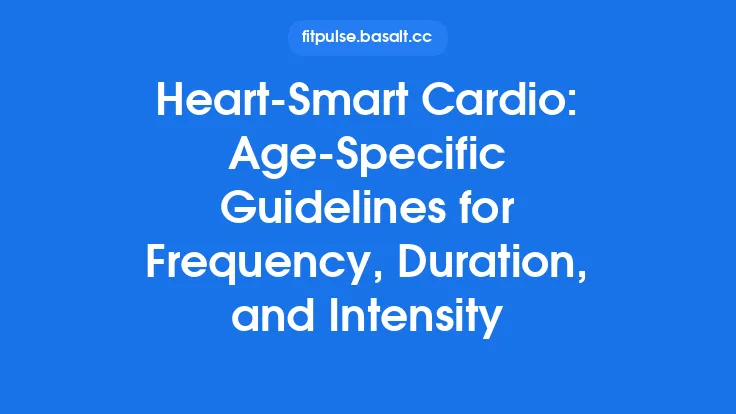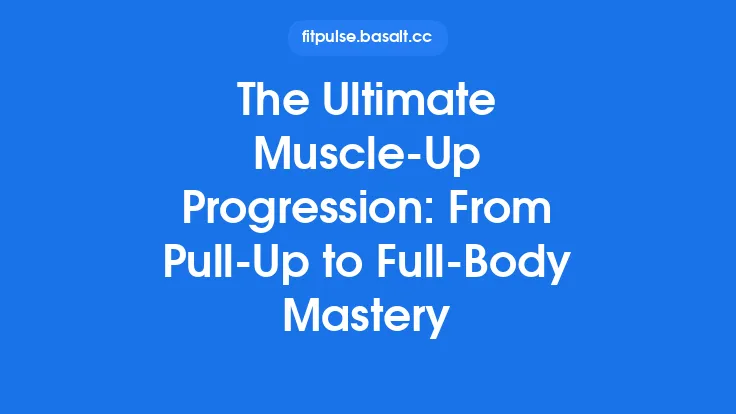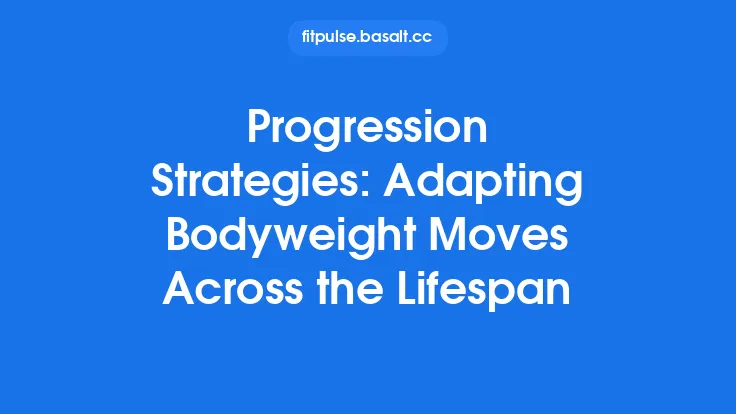Cardiovascular conditioning is one of the few fitness domains that can be cultivated throughout an entire life span, yet the way we build and evolve cardio programs must shift as the body matures, peaks, and eventually ages. Understanding the underlying physiological transformations that occur from the teenage years to the later decades, and aligning those changes with sound programming principles, allows athletes, recreational exercisers, and health‑focused individuals to keep their hearts strong, their endurance improving, and their overall well‑being resilient. Below is a comprehensive guide to constructing progressive cardio regimens that respect the unique demands of each life stage while adhering to timeless training concepts.
The Biological Landscape of Cardio Across the Ages
Adolescence (≈12‑19 years)
- Cardiac Output & Stroke Volume: Rapid growth of the heart muscle and blood volume leads to a marked increase in maximal cardiac output.
- VO₂max Trajectory: VO₂max rises sharply during puberty, driven by hormonal surges (testosterone, growth hormone) and expanding muscle mass.
- Metabolic Flexibility: Youthful muscles are highly oxidative, allowing efficient utilization of both carbohydrates and fats during prolonged effort.
- Recovery Capacity: Elevated anabolic hormone levels and robust cellular repair mechanisms grant adolescents a relatively quick bounce‑back from high‑intensity work.
Early to Mid‑Adulthood (≈20‑45 years)
- Plateau Phase: After the growth spurt, VO₂max stabilizes, and cardiac dimensions reach adult norms.
- Hormonal Shifts: Gradual declines in anabolic hormones begin, subtly influencing recovery and adaptation rates.
- Mitochondrial Density: With consistent training, mitochondrial biogenesis can be maintained, but the ceiling for improvement is lower than in adolescence.
- Lifestyle Interplay: Work, family, and social commitments introduce variability in sleep, nutrition, and stress, all of which modulate cardio adaptation.
Late Adulthood & Senior Years (≈46 years onward)
- Cardiac Remodeling: A modest reduction in maximal heart rate (≈1 bpm per year) and slight decreases in stroke volume are typical.
- VO₂max Decline: Without targeted stimulus, VO₂max can drop 5‑10 % per decade; however, well‑designed programs can blunt this loss dramatically.
- Arterial Stiffness & Endothelial Function: Vascular compliance diminishes, affecting blood flow dynamics during exercise.
- Recovery & Fatigue: Cellular repair slows, and perceived exertion rises for a given workload, necessitating more strategic load management.
Understanding these shifts is the foundation for any progressive cardio plan. The goal is not to prescribe a one‑size‑fits‑all prescription but to align training variables with the body’s evolving capacity to respond.
Core Programming Pillars That Remain Evergreen
- Progressive Overload – Incrementally increasing the stimulus (volume, intensity, or modality) forces the cardiovascular system to adapt.
- Periodization – Organizing training into macro‑, meso‑, and micro‑cycles creates structured phases of stress and recovery.
- Specificity – Tailoring the stimulus to the desired outcome (e.g., aerobic endurance vs. anaerobic capacity) ensures efficient adaptation.
- Variation – Rotating modalities, terrain, and interval structures prevents monotony and mitigates plateau formation.
- Recovery Integration – Planned deloads and active recovery sessions allow the heart, vasculature, and supporting musculature to rebuild.
These principles are timeless; what changes is how they are applied at each life stage.
Designing a Macrocycle for the Lifespan
A macrocycle typically spans 6‑12 months and serves as the overarching roadmap. Below is a scaffold that can be customized for each age group.
| Phase | Primary Objective | Typical Emphasis | Adaptation Focus |
|---|---|---|---|
| Foundational Base | Build aerobic engine, reinforce movement efficiency | Long, steady‑state sessions (45‑90 min) at moderate intensity | Mitochondrial density, capillary proliferation |
| Strength‑Endurance | Enhance ability to sustain higher workloads | Tempo runs, threshold intervals, moderate‑length repeats | Lactate clearance, stroke volume expansion |
| Peak Power | Maximize VO₂max and anaerobic capacity | Short, high‑intensity intervals (30 s‑4 min) with ample rest | Cardiac output surge, neuromuscular recruitment |
| Transition / Deload | Consolidate gains, prevent overreaching | Reduced volume, mixed low‑intensity work | Autophagy, hormonal re‑balancing |
| Maintenance / Longevity | Preserve cardiovascular health, support functional mobility | Balanced mix of moderate endurance and occasional bursts | Vascular compliance, metabolic flexibility |
Adolescent Adaptation: The macrocycle can lean heavily on the Foundational Base and Strength‑Endurance phases, with a relatively brisk progression into Peak Power because of superior recovery capacity.
Adult Adaptation: A more measured transition between phases is advisable. The Transition phase may be lengthened to accommodate life stressors, and the Maintenance phase can be introduced earlier to sustain performance while balancing work‑life demands.
Senior Adaptation: Emphasize a prolonged Foundational Base and a gentle Strength‑Endurance phase. The Peak Power segment should be brief, low‑volume, and highly controlled, followed by an extended Transition period to ensure adequate recovery.
Mesocycle Blueprint: Applying the Pillars
Within each macro phase, mesocycles (3‑6 weeks) operationalize overload and variation.
1. Volume Manipulation
- Adolescents: Increase weekly mileage or session duration by ~10 % per mesocycle, capitalizing on rapid adaptation.
- Adults: Adopt a 5‑7 % weekly increase, interspersed with a “recovery week” (reduced volume by 20‑30 %).
- Seniors: Prioritize modest volume growth (3‑5 % per mesocycle) and incorporate cross‑training (e.g., rowing, elliptical) to reduce joint stress.
2. Intensity Progression
- Adolescents: Introduce higher‑intensity intervals early, using heart‑rate zones as a guide but focusing on perceived effort.
- Adults: Cycle intensity in a “wave” pattern—moderate, high, moderate—over the mesocycle to manage fatigue.
- Seniors: Keep high‑intensity work short (≤30 seconds) and infrequent (once per week), gradually extending the work interval only after clear tolerance.
3. Modality Rotation
- Adolescents: Alternate running, swimming, and cycling every 2‑3 weeks to develop a broad aerobic base.
- Adults: Use modality swaps to address specific performance goals (e.g., cycling for leg endurance, rowing for upper‑body cardio).
- Seniors: Emphasize low‑impact options (water‑based cardio, recumbent bike) while still offering occasional weight‑bearing sessions for bone health.
4. Recovery Scheduling
- Adolescents: 1‑2 rest days per week, with optional active recovery (light mobility work).
- Adults: 2 rest days, with at least one “active recovery” session (easy pace, low‑intensity).
- Seniors: 2‑3 rest days, and consider “recovery weeks” every 4‑5 weeks where total cardio load is cut by 30‑40 %.
Mesocycle Example: “Strength‑Endurance” for a 55‑Year‑Old
| Week | Session 1 | Session 2 | Session 3 | Session 4 |
|---|---|---|---|---|
| 1 | 45 min steady bike @ 65 % HRmax | 30 min tempo run @ 75 % HRmax | 40 min elliptical (intervals: 2 min moderate / 1 min brisk) | Rest |
| 2 | 50 min steady bike @ 66 % HRmax | 35 min tempo run @ 76 % HRmax | 45 min elliptical (intervals: 2 min moderate / 1 min brisk) | Rest |
| 3 | 55 min steady bike @ 68 % HRmax | 40 min tempo run @ 78 % HRmax | 50 min elliptical (intervals: 2 min moderate / 1 min brisk) | Rest |
| 4 (Deload) | 35 min easy bike @ 60 % HRmax | 25 min easy walk | 30 min easy elliptical | Rest |
Note: The progression is modest, focusing on slight volume and intensity increases while preserving ample recovery.
Microcycle Tactics: Fine‑Tuning the Daily Load
A microcycle (typically a week) is where the day‑to‑day decisions happen. Key tactics include:
- Undulating Intensity: Vary the intensity across the week (e.g., hard‑day, easy‑day, moderate‑day) to keep the cardiovascular system challenged without overtaxing it.
- Session Pairing: Pair a high‑intensity interval session with a low‑intensity steady session on adjacent days to balance stress.
- Time‑of‑Day Considerations: Adolescents often thrive with morning sessions due to higher natural energy; adults may benefit from evening workouts after work; seniors may prefer mid‑day when body temperature peaks, aiding joint mobility.
- Nutrition Timing: Align carbohydrate intake with higher‑intensity days to support glycogen replenishment, while emphasizing protein and healthy fats on recovery days.
Transitioning Between Life Stages
The shift from one age bracket to the next is not abrupt; it is a continuum. Below are practical guidelines for navigating these transitions.
From Adolescence to Early Adulthood
- Gradual Volume Reduction: As academic or career responsibilities increase, trim weekly cardio volume by ~10‑15 % while preserving intensity to maintain VO₂max.
- Introduce Structured Periodization: Move from ad‑hoc “play‑hard” sessions to a clear macro‑meso‑micro framework, which aids in balancing training with new life demands.
- Focus on Skill Transfer: If the adolescent was a competitive runner, incorporate cross‑training to preserve cardiovascular fitness while reducing impact stress.
From Early to Late Adulthood
- Prioritize Recovery: Extend deload weeks to every 4‑5 weeks, and incorporate restorative modalities (e.g., gentle yoga, mobility drills).
- Shift Goal Emphasis: Transition from performance‑centric targets (race times) to health‑centric outcomes (maintaining functional capacity).
- Re‑evaluate Modality Mix: Replace high‑impact activities with lower‑impact equivalents to protect joints while still delivering cardiovascular stimulus.
From Late Adulthood to Senior Years
- Emphasize Consistency Over Intensity: Small, frequent bouts of cardio (e.g., 20‑minute walks) become more valuable than occasional high‑intensity sessions.
- Integrate Functional Movements: Pair cardio with activities that mimic daily tasks (e.g., stair climbing, brisk walking with light resistance bands) to support independence.
- Monitor Health Markers: While not delving into specific metrics, maintain regular communication with healthcare providers to ensure the cardio load aligns with overall health status.
Selecting the Right Cardio Modality for Each Stage
| Age Group | Ideal Modalities | Rationale |
|---|---|---|
| Adolescents | Running, swimming, team sports, high‑intensity circuit cardio | Leverages high energy, promotes bone density, and aligns with social engagement. |
| Adults | Cycling, rowing, interval treadmill work, group fitness classes | Offers versatility for time‑constrained schedules and balances impact with cardiovascular demand. |
| Seniors | Aquatic aerobics, recumbent cycling, elliptical, brisk walking | Low‑impact yet effective at stimulating heart and lung function, while protecting joints. |
When choosing a modality, consider the individual’s skill set, injury history, and personal enjoyment—factors that heavily influence long‑term adherence.
The Role of Autoregulation in Lifespan Cardio
Autoregulation—adjusting training load based on day‑to‑day readiness—becomes increasingly valuable as the body ages. Simple cues include:
- Perceived Energy Levels: A “ready” versus “dragged” feeling can dictate whether to push intensity or opt for a lighter session.
- Heart‑Rate Variability (HRV) Trends: While not a dedicated monitoring tool, noticing patterns (e.g., consistently low HRV) can signal the need for additional recovery.
- Sleep Quality: Poor sleep nights warrant reduced volume or intensity, especially for seniors whose recovery windows are narrower.
Embedding autoregulation within the periodized framework ensures that the program remains responsive to physiological fluctuations without requiring complex tracking systems.
Sustainability: Building a Cardio Habit That Lasts
Even the most scientifically sound program fails if it cannot be sustained. The following evergreen strategies help embed cardio into daily life across all ages:
- Anchor Sessions to Existing Routines – Pair a cardio workout with a non‑negotiable activity (e.g., after work, before dinner).
- Social Integration – Join community runs, cycling clubs, or virtual challenges that provide accountability and enjoyment.
- Environmental Variety – Rotate indoor and outdoor venues to keep the experience fresh and to expose the body to different stimuli (temperature, terrain).
- Progressive Goal Setting – While avoiding formal “motivation” sections, simply celebrate incremental milestones (e.g., adding 5 minutes to a walk) to reinforce the habit loop.
- Seasonal Adjustments – Align modality choices with weather patterns (e.g., indoor rowing in winter, trail running in spring) to avoid weather‑related drop‑offs.
Putting It All Together: A Sample Year‑Long Roadmap
Below is a high‑level illustration of how a progressive cardio program might evolve from age 15 to age 70, emphasizing the shift in emphasis rather than prescribing exact numbers.
| Age | Macro Phase Focus | Typical Weekly Structure | Key Progression Strategy |
|---|---|---|---|
| 15 – 18 | Foundational Base → Strength‑Endurance | 4–5 sessions: 2 long steady, 1 tempo, 1 interval, 1 active recovery | Increase weekly volume by 10 % each mesocycle; introduce short intervals (30 s) by year 2 |
| 20 – 35 | Strength‑Endurance → Peak Power | 4 sessions: 1 long steady, 1 tempo, 1 high‑intensity interval, 1 mixed modality | Cycle intensity weekly (moderate → high → moderate); incorporate modality swaps every 6 weeks |
| 36 – 50 | Peak Power → Maintenance | 3–4 sessions: 1 long steady, 1 interval block, 1 mixed low‑impact, optional 4th light session | Extend deload weeks to every 5th week; reduce high‑intensity volume by 20 % while preserving frequency |
| 51 – 65 | Maintenance → Longevity | 3 sessions: 1 steady low‑impact, 1 moderate interval, 1 functional cardio (e.g., stair circuits) | Emphasize consistent weekly volume; increase recovery days; integrate functional movements |
| 66 + | Longevity & Functional Mobility | 2–3 sessions: 1 brisk walk or water‑aerobics, 1 light interval (≤30 s), 1 optional mobility‑cardio blend | Prioritize consistency; keep intensity low; focus on enjoyment and independence |
The roadmap demonstrates a natural tapering of high‑intensity work and a gradual shift toward volume consistency and functional relevance as age advances. By adhering to the core programming pillars—progressive overload, periodization, specificity, variation, and recovery—each individual can experience continuous cardiovascular improvement, regardless of life stage.
Final Thoughts
Progressive cardio programming is less about a static set of prescriptions and more about a dynamic, lifespan‑aware framework. By recognizing the physiological realities of adolescence, adulthood, and senior years, and by applying timeless training principles in a stage‑appropriate manner, we can craft cardio regimens that not only boost performance but also safeguard heart health, enhance quality of life, and foster a lifelong love of movement. The key lies in thoughtful progression, strategic periodization, and an unwavering commitment to adapting the program as the body evolves—ensuring that the heart remains strong from the first sprint of youth to the gentle stroll of the golden years.





